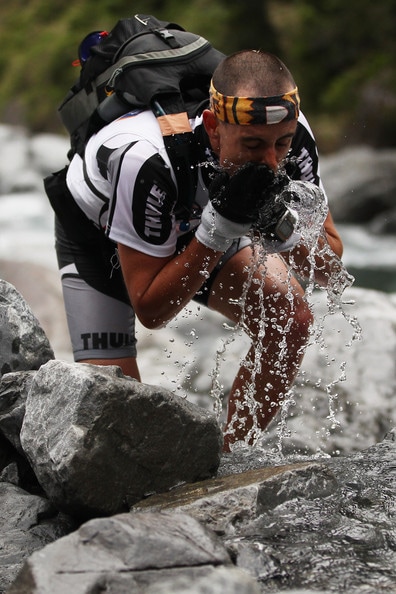| Ignore talk about drinking a minimum number of cups of water a day. The truth is much simpler. People are often surprised by how well their body works. Many health problems occur simply because we have ignored or overridden the body’s own systems. This goes for the shoes we wear. It also goes for the fluids we drink. People have spent a lot of time working out the optimum fluid intake for healthy living and exercise. Much of that work has been used to make money telling you to buy certain products or heed a certain stream of advice. Nearly all of it is useless for the practical purposes of a lifelong runner. For hydrating on the run your body does the calculations for you with a great deal more accuracy. |
The result is this very simple bit of advice - drink when you are thirsty.
The only reason you need to consider this at all is if you are embarking on a long run, say more than an hour, somewhere where appropriate fluids may not be freely available or in extreme heat. This can then be an important safety measure as much as a performance consideration.
In our everyday lives most of us are not accustomed to feeling thirsty, as we drink throughout the day. Thirst has become seen as an early warning sign of dehydration. Technically this is true, but it’s a very early warning sign, in the same way that feeling peckish is a very early warning sign of starvation.
You should not ignore either signal from your body. That would be foolish, especially if you are hoping to perform to your best. But there’s no need to try to avoid ever feeling thirsty any more than there is a need to avoid feeling like a snack. Studies have shown drinking to excess is far more dangerous to your health than delaying drinking and waiting until your thirst tells you that you need to drink.
During events you should base your fluid intake on water, and any food intake as close to your everyday food as possible. This will reduce the risk of stomach upsets. Save the 'sports drinks', 'electrolytes' and gels for the most extreme circumstances. You shouldn’t need them unless you are going for more than a couple of hours between aid stations.
Part of your training is working on how your everyday nutrition and hydration routines perform when you exercise. Ideally you will be exercising consistently as an everyday part of your daily routines. So there should be little or no difference in what you need to eat or drink whether you are running or not. Your body should be properly maintained for action at all times. If anything, you might go for ‘more of the same’ to keep you active much longer than normal.
Be aware and take careful note of how this naturally varies according to when you exercise, what you do, what time of the day you do it, the weather etc. This will provide you with the guidance you need for the big events.
It will also provide the minimum you need to carry if away from water sources. You will need to allow for any of the possible variations you have noted. Then you might like to add a little more in case of emergency. You can read more about this last safety point here.
The only other consideration is if travelling to your event causes an abrupt change in climate or altitude. If so special measures might be needed to supplement that change. In those instances it’s good to heed the advice of those with experience. But keep the above baseline rules in mind.
The more you get used to living in a readiness state in this way, the more comfortable you are going to be out running. It is from this place of relative comfort that you can then push harder and harder if you choose to. Trying to shock your system beyond its comfort zone with food and drink you wouldn’t otherwise select is not going to work out well in the long run.
If you found this article thought provoking, or confronting, leave me a comment below or send me an email. Click here to receive more articles like this one.




